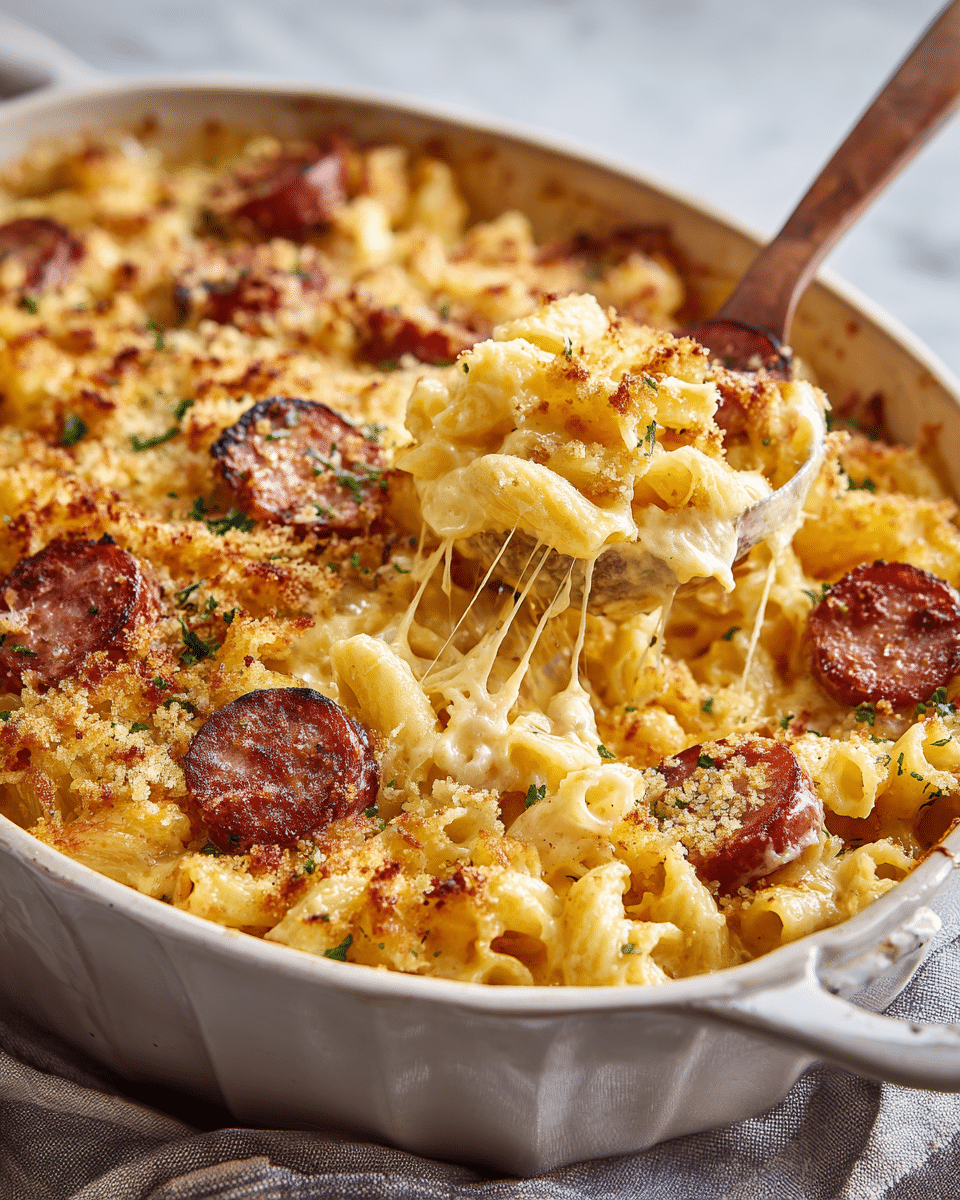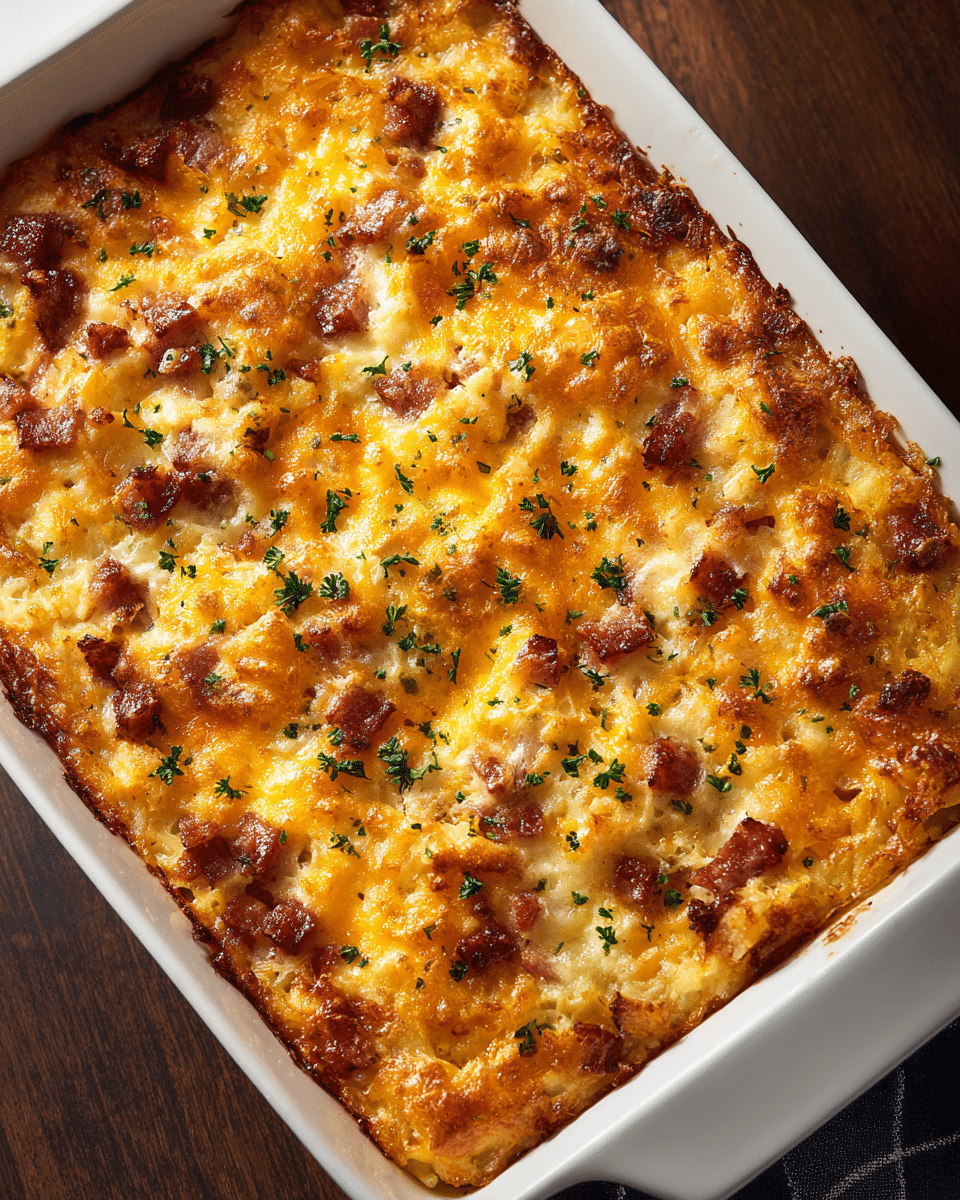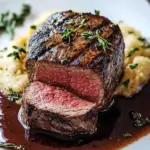Kielbasa and Sauerkraut Skillet is a hearty, one-pan dish rooted in Eastern European tradition, offering a comforting blend of smoky sausage and tangy fermented cabbage. This simple yet flavorful recipe is perfect for weeknight dinners or as a rustic meal for family gatherings. The savory kielbasa is seared to perfection, then simmered with onions, garlic, sauerkraut, and a touch of mustard to deepen the flavor. Served hot from the skillet, it’s a satisfying dish that brings warmth and bold taste to the table with minimal fuss.
FULL RECIPE
Ingredients
- 1 tablespoon olive oil
- 1 (14 oz) kielbasa sausage, sliced into ½-inch rounds
- 1 medium yellow onion, thinly sliced
- 2 cloves garlic, minced
- 1 apple, peeled and diced (optional for sweetness)
- 3 cups sauerkraut, drained (but not rinsed)
- ½ teaspoon caraway seeds (optional, for traditional flavor)
- 2 teaspoons Dijon mustard
- ¼ teaspoon black pepper
- ½ cup chicken broth or water
- 1 tablespoon butter (optional, for richness)
- Chopped fresh parsley, for garnish (optional)
Directions
- Heat the olive oil in a large skillet over medium heat.
- Add the sliced kielbasa and cook for 5–6 minutes, turning occasionally, until the sausage is browned on both sides. Remove the sausage from the skillet and set aside.
- In the same skillet, add the sliced onion and cook for 4–5 minutes, stirring occasionally, until softened and lightly caramelized.
- Stir in the minced garlic and diced apple, cooking for another 2 minutes until fragrant.
- Add the drained sauerkraut to the skillet along with the caraway seeds, Dijon mustard, and black pepper. Stir everything together until well combined.
- Return the browned kielbasa to the skillet and pour in the chicken broth. Stir to distribute the liquid evenly.
- Cover the skillet and simmer on low heat for 10–12 minutes, allowing the flavors to meld together.
- Uncover the skillet and stir in the butter, if using. Let cook uncovered for another 2–3 minutes to allow some of the liquid to evaporate.
- Garnish with chopped fresh parsley, if desired, and serve hot.
Nutrition Facts
- Calories: 340
- Total Fat: 25g
- Saturated Fat: 9g
- Trans Fat: 0g
- Cholesterol: 60mg
- Sodium: 1180mg
- Total Carbohydrates: 14g
- Dietary Fiber: 3g
- Sugars: 6g
- Protein: 14g
- Vitamin A: 2% DV
- Vitamin C: 20% DV
- Calcium: 4% DV
- Iron: 8% DV
The History Behind Kielbasa and Sauerkraut Skillet
Kielbasa and sauerkraut is a dish steeped in Central and Eastern European culinary tradition, particularly Polish and German. Kielbasa, a word simply meaning “sausage” in Polish, comes in many varieties, but the smoked version is most commonly used in this skillet recipe. Sauerkraut, fermented cabbage, dates back thousands of years and was historically prized for its ability to preserve vegetables through harsh winters. The pairing of kielbasa with sauerkraut reflects a practical, flavorful combination that has long been a staple of hearty, rustic meals in cold climates. Over time, the dish has been embraced globally, with regional twists and personalized methods that continue to evolve today.
Flavor Profile and Texture Dynamics
This skillet dish offers a rich combination of smoky, tangy, and slightly sweet flavors. The kielbasa delivers bold umami notes and a firm bite, thanks to the smoking process, while sauerkraut brings a lively tartness and slight crunch that balances the richness of the sausage. When cooked together, the juices from the kielbasa infuse the sauerkraut, creating a depth of flavor that’s comforting yet robust. Adding onions, garlic, or even diced apples introduces sweetness and aromatic complexity, enhancing the overall dish without overpowering its core character.
Nutritional Value and Health Benefits
Kielbasa and sauerkraut may not initially strike one as a “health food,” but it offers several nutritional advantages when made thoughtfully. Kielbasa is high in protein and provides essential B vitamins, iron, and zinc, supporting muscle function and energy metabolism. Sauerkraut, being a fermented food, contains probiotics that aid digestion and support gut health. It’s also low in calories and high in fiber and vitamin C. Using leaner kielbasa or turkey sausage can reduce saturated fat, and incorporating apples or other vegetables boosts the dish’s fiber and nutrient profile.
Popular Variations to Try
There are many ways to customize a kielbasa and sauerkraut skillet to suit different tastes and dietary needs. Some cooks like to add diced potatoes or sweet potatoes for heartiness, turning it into more of a complete one-pan meal. Others prefer to mix in bell peppers, mushrooms, or carrots to brighten the dish both visually and nutritionally. For extra heat, adding a dash of crushed red pepper flakes or sliced jalapeños works well. A splash of beer or apple cider during cooking can add a deeper, more complex flavor, especially for autumn-inspired versions.
Best Side Dishes and Pairings
While the dish can stand on its own, it also pairs wonderfully with a variety of side dishes. Crusty rye bread or German-style pretzels make great accompaniments for soaking up juices. For something lighter, consider a side salad with a bright vinaigrette to cut through the richness. Boiled or mashed potatoes are a classic match, grounding the meal in hearty tradition. For drinks, amber lagers, pilsners, or a dry Riesling complement the savory and sour elements of the dish without overwhelming the palate.
Cooking Tips for the Perfect Skillet
To achieve the best texture and flavor, it’s important to brown the kielbasa slices thoroughly before adding the rest of the ingredients. This caramelization process adds depth and enhances the smokiness of the sausage. Draining, but not rinsing, the sauerkraut is key—this retains its tanginess without making the dish overly sour. Cooking everything slowly over low heat allows the flavors to meld, while a small amount of broth or cider can prevent the skillet from drying out. If you prefer a softer sauerkraut texture, simmer longer with the lid on.
Storage and Reheating Guidelines
Kielbasa and sauerkraut skillet stores exceptionally well, making it ideal for meal prep. After cooling, place leftovers in an airtight container and refrigerate for up to four days. The flavors actually intensify as it rests, often tasting even better the next day. For reheating, use a skillet over low heat to preserve texture, or microwave in short intervals while stirring in between. If the dish seems dry during reheating, a splash of broth or water will help bring it back to its original consistency.
Serving Suggestions for Different Occasions
This dish’s versatility makes it suitable for a range of events—from casual weeknight dinners to festive holiday gatherings. Serve it over egg noodles or spaetzle for a comforting winter meal, or dish it out on top of warm potato pancakes for an Oktoberfest-inspired feast. For a more casual setting, serve it in sandwich rolls as kielbasa-sauerkraut hoagies. Add a side of pickles or a tangy mustard sauce for extra zing. Its ease of preparation also makes it ideal for camping or potluck events where robust, crowd-pleasing meals are essential.
Gluten-Free and Low-Carb Adaptations
For those following a gluten-free or low-carb lifestyle, this dish is easily adaptable. Most sauerkraut is naturally gluten-free, but it’s important to check labels for any additives. Use a certified gluten-free kielbasa and ensure any broth or mustard used is also safe. To lower the carb content, avoid serving it with bread or potatoes and instead pair it with a leafy green salad or roasted non-starchy vegetables. This simple adjustment transforms the dish into a keto-friendly or paleo-compatible option without compromising flavor.
Cultural Significance and Regional Identity
Kielbasa and sauerkraut hold strong cultural identities, particularly among Polish, German, and other Central European communities. In Polish-American households, it’s a staple during holidays like Christmas and Easter. Similarly, Germans might enjoy a version of it during Oktoberfest or in hearty winter meals. These culinary traditions have carried over to the U.S. Midwest, where the dish is embraced as a nod to immigrant heritage and rural comfort. As such, it’s more than just a quick dinner—it’s a nostalgic connection to ancestry, often passed down through generations.
Conclusion
The Kielbasa and Sauerkraut Skillet is more than just a fast, flavorful meal—it’s a celebration of culinary tradition, nutrition, and adaptability. Whether you’re seeking comfort food, honoring cultural roots, or simply using what’s in your fridge, this dish delivers. With endless room for variation and a rich base of taste and texture, it can be customized to suit any season, dietary need, or occasion. From its probiotic-rich sauerkraut to the satisfying smokiness of kielbasa, every bite tells a story of resourceful, hearty cooking at its best.








